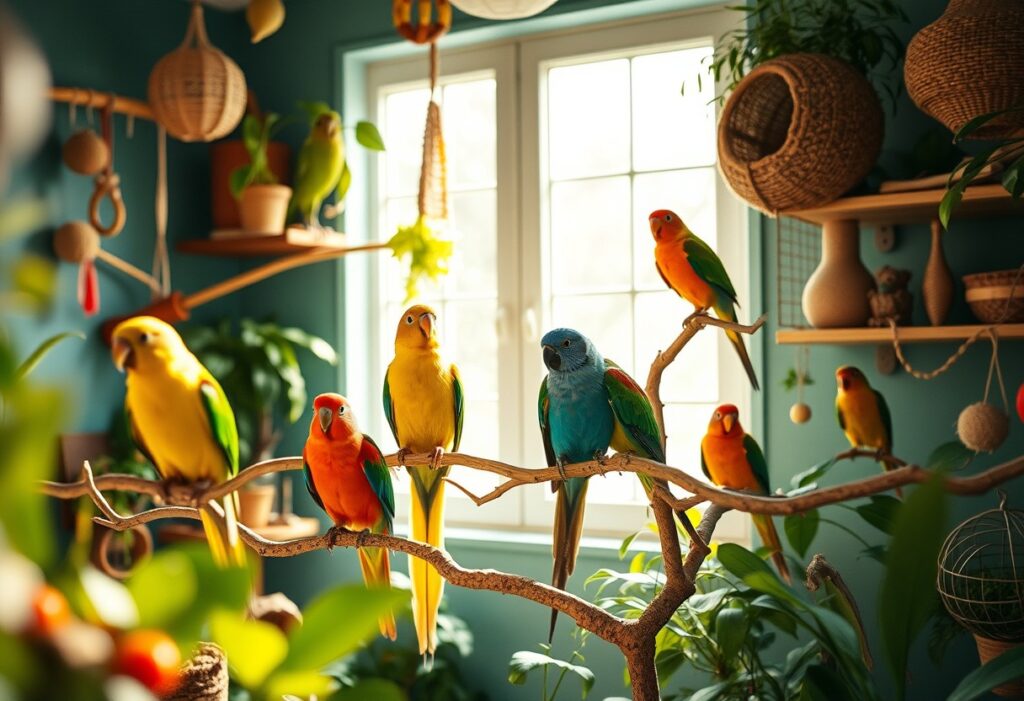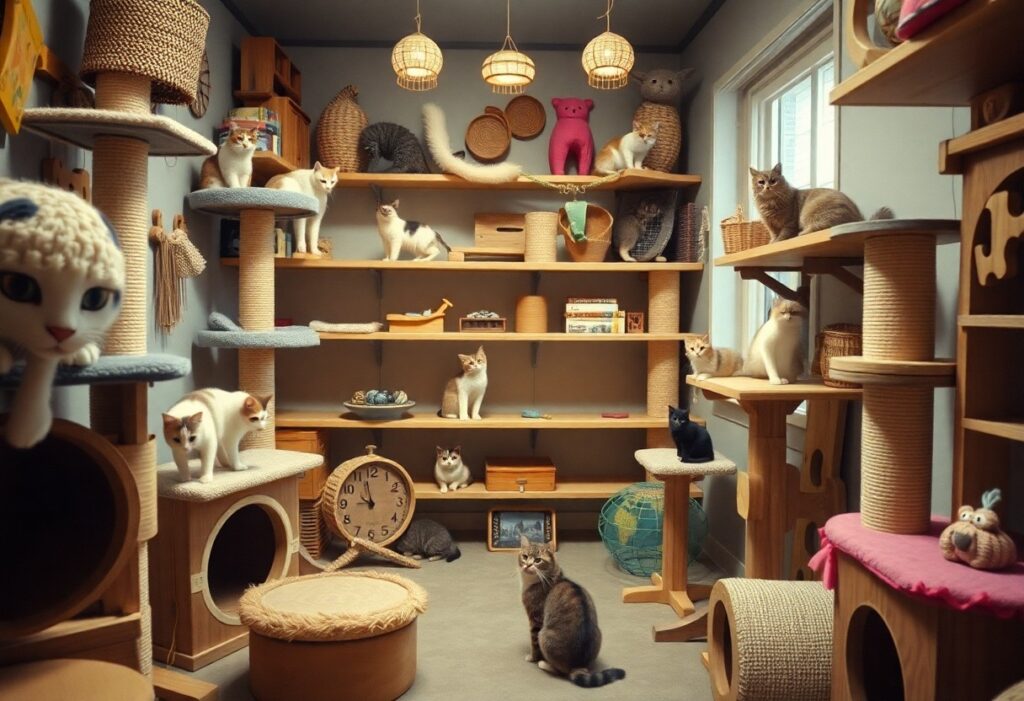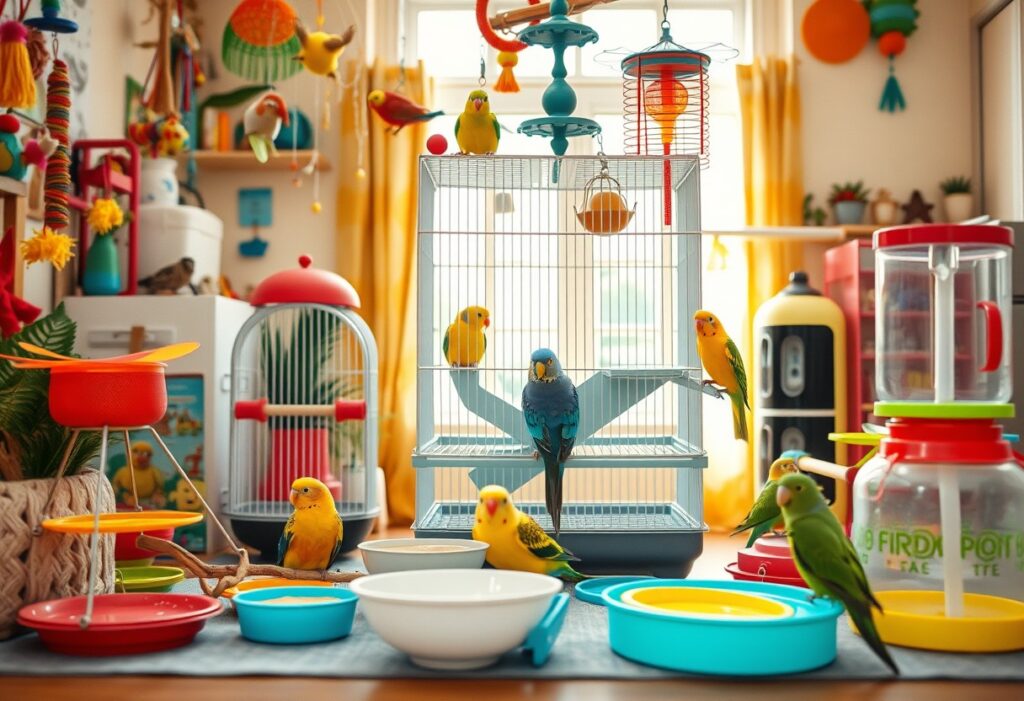Many pet bird owners underestimate the importance of providing a safe and stimulating environment for their feathered friends. Creating an ideal space not only ensures your bird’s physical safety but also promotes mental well-being through enriching activities. You need to consider factors such as cage design, placement, and the presence of toys and perches to keep your bird engaged and happy. In this guide, we will explore imperative steps to help you transform your living space into a haven that caters to your pet bird’s needs.
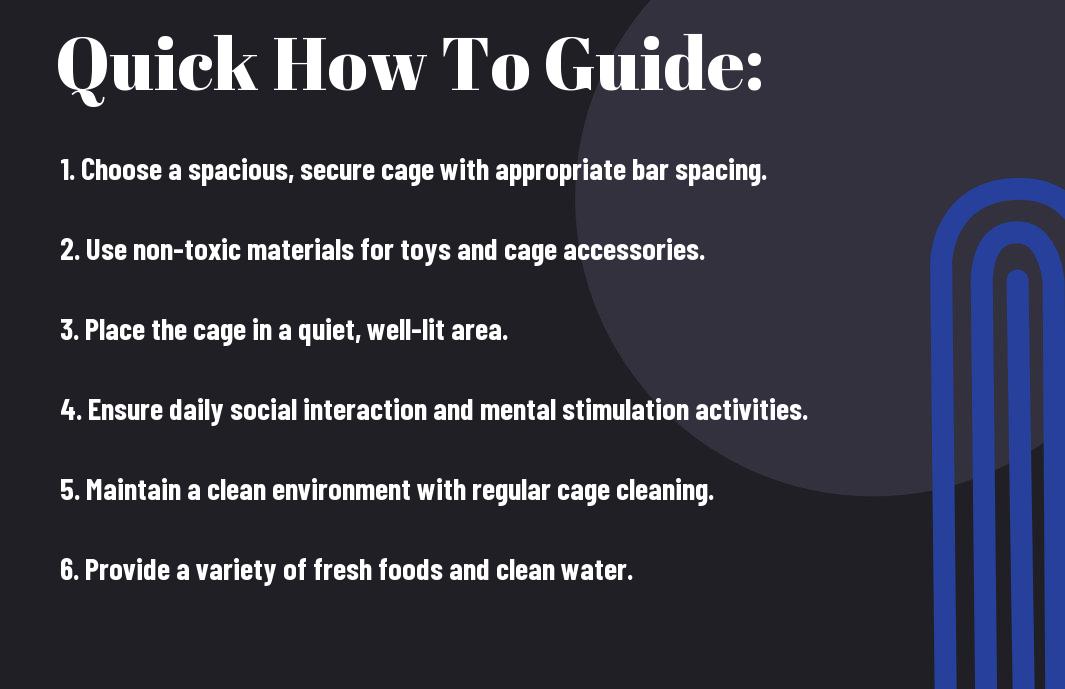
Understanding Your Bird’s Needs
While every pet bird has unique requirements influenced by its species, size, and age, understanding the fundamental needs of your feathered friend is important for fostering a happy and healthy environment. By being informed about their natural habitat, social needs, and dietary requirements, you can ensure that your pet bird thrives in your care.
Natural Habitat Considerations
To create a suitable environment for your bird, you must first consider its natural habitat. Birds come from a variety of ecosystems, ranging from dense forests to open savannahs. Take time to research the specific environment of the species you have, as this information will guide you in replicating their habitat at home. For example, tropical birds may require a warmer temperature and higher humidity, while more temperate species may thrive in cooler conditions.
Additionally, providing adequate space for your bird is vital. Ensure its cage mimics its natural environment with plenty of room for movement and play, as well as providing vertical space for climbing. The cage should be large enough to accommodate toys, perches, and other stimulating items, making it a fulfilling space that caters to your bird’s instincts.
Social Interaction Requirements
There’s no denying that birds are social creatures. Most species thrive on social interaction, whether with humans or other birds. It’s important to spend quality time engaging with your feathered friend daily, as neglecting their need for companionship can lead to behavioral issues and stress. Focus on developing a bond through activities, such as talking, playing, and training, to enrich your bird’s life.
For instance, many birds actively seek mental stimulation through social play. Engaging them with toys that encourage interaction, and rotating those toys regularly, can keep your bird mentally fit and reduce boredom. Understanding your bird’s body language can also aid you in identifying when they crave more interaction, allowing you to meet their social needs effectively.
Diet and Nutritional Factors
While every bird has dietary preferences influenced by its species, proper nutrition is paramount in ensuring the health and longevity of your pet bird. Provide a balanced diet that includes a mix of **high-quality pellets**, **fresh fruits**, and **vegetables**. Incorporating sources of **calcium** and **protein** will also support your bird’s overall well-being. Avoid feeding human food that poses risks, such as **avocado** or **caffeine**, as these can be harmful to your feathered companion.
- Include **fresh fruits** and **vegetables** for vitamins.
- Invest in **premium pellets** tailored for your bird’s species.
- Monitor the intake of **seeds**, as they can sometimes lead to obesity.
The importance of hydration cannot be overstated; always ensure your bird has access to fresh, clean water.
Nutritional needs can vary significantly among bird species, so it’s important to consult with an avian veterinarian to establish a tailored dietary plan for your bird. For example, while seed mixes can provide some important nutrients, relying solely on them may lead to deficiencies in crucial vitamins and minerals.
- Research your bird’s specific **dietary requirements** based on species.
- Regularly consult with an **avian vet** for the best health practices.
- Consider using **supplements** to fill any nutritional gaps.
The right diet is a foundation for a long, healthy life for your pet bird.
Creating a Safe Living Space
The importance of creating a secure and stimulating environment for your pet bird cannot be overstated. Your feathered companion spends a significant amount of time inside its cage, which means that this space should be both safe and enriching. By thoughtfully selecting the right cage and furnishings, you can provide a sanctuary that promotes your bird’s well-being while protecting it from potential hazards.
Choosing the Right Cage
Safe cage selection is crucial for your bird’s health and happiness. When choosing a cage, look for one that adheres to your bird’s size and species needs; for example, larger birds require bigger cages with horizontal bars for climbing, while smaller birds can thrive in more compact spaces. Also, opt for a cage made from non-toxic materials, such as powder-coated or stainless steel, to prevent harmful chemical exposure.
Additionally, ensure that the cage has adequate ventilation, ample space for movement, and features like removable trays for easier cleaning. It’s also wise to choose a cage with a suitable bar spacing to prevent your bird from getting stuck or escaping. Keep in mind, a well-chosen cage not only keeps your bird secure but also contributes significantly to its overall happiness.
Safe Toys and Accessories
There’s nothing quite like seeing your bird engage with toys and accessories that are tailored for its needs. Providing your bird with a variety of safe toys helps to alleviate boredom and keeps it mentally stimulated. Aim to incorporate a mix of natural wood, cotton, and other non-toxic materials that are safe for chewing and playing. Avoid plastic toys that can break easily, as sharp edges can pose a risk.
To enhance your bird’s environment further, consider adding climbing structures, perches of varying sizes, and even foraging toys filled with healthy treats. These elements will encourage physical activity and curiosity while also ensuring that your bird has a fulfilling and engaging atmosphere. Always remember to regularly inspect toys for wear and tear to maintain a safe environment.
Hazardous Materials to Avoid
Any responsible bird owner should be aware of hazardous materials that can lead to serious health risks for their pet. Common household items like teflon-coated cookware, certain air fresheners, and cleaning supplies contain chemicals that can be toxic to birds, often resulting in respiratory issues. It’s crucial to keep your bird in a space free of these harmful substances and to ventilate areas when using such products.
Safe practices also extend to food, where certain human foods like chocolate, avocado, and caffeine can be extremely dangerous for birds. Always do your research and have a clear understanding of what is safe for your feathered friend to prevent any unexpected health issues in the future.

Stimulating Your Bird’s Environment
Despite the common misconception that all birds are content with a basic cage setup, creating a rich and dynamic environment is crucial for their overall well-being. Birds are intelligent creatures that thrive on mental challenges and sensory engagement. By consistently stimulating your bird’s environment, you can help prevent boredom-related behaviors such as excessive screaming or feather plucking. Engaging their minds is just as vital as fulfilling their physical needs, as it promotes a healthier, happier pet.
Importance of Mental Stimulation
There’s no denying that birds are highly intelligent and social animals. They require not just physical exercise but also mental challenges to keep their brains engaged. Providing your bird with varied activities and toys can mimic the complexities of their natural habitat. When your bird is mentally stimulated, it will be more inclined to exhibit positive behaviors, leading to a harmonious living situation for both of you.
Exposing your avian friend to different stimuli—such as unique toys, puzzles, or foraging activities—can greatly enhance their cognitive skills. This not only keeps your bird entertained but also helps in developing problem-solving capabilities, which are vital for their cognitive health. Keep in mind, the more variety you introduce to their environment, the more their natural instincts will thrive.
Introducing New Experiences
Stimulating your bird doesn’t just stop at toys and treats; it’s equally important to introduce new experiences. This can include varying their surroundings by changing the layout of their cage, bringing in different perches, or even transitioning to a new location within your home. You might also expose them to new sounds, sights, and smells. Keeping things fresh and exciting will encourage curiosity and exploration in your bird.
For instance, consider letting your bird enjoy safe outdoor time in a secure harness or playpen, where they can observe the world beyond the confines of your home. This is an enriching experience that allows them to encounter different sights and sounds, helping to stimulate their senses in a natural way. You might also engage them with seasonal decorations around their cage, introducing new colors and shapes to keep their environment lively and varied.
Socialization Techniques
Some birds thrive on social interaction and can become bored or anxious without engaging companionship. Socialization is vital for your bird’s development, and it can take many forms. Regular interaction with you or other pets can help fulfill their social needs. Consider spending dedicated time each day where you talk, sing, or even train them to perform simple tricks. These interactions are not only fun for you and your bird but serve to strengthen your bond.
Encouraging your bird to meet new people or other birds (if safe) can also provide beneficial social experiences. Taking your bird to pet-friendly locations or safely setting up playdates with other bird owners can help your feathered friend develop important social skills and adapt to varied situations.
Mental stimulation in the form of positive social interactions can lead to reduced anxiety and enhanced well-being. Engaging your bird with activities that involve both mental and social aspects can create a more fulfilling life for them. Whether it’s through training, playtime, or simply enjoying each other’s company, always find opportunities to enrich their lives socially.
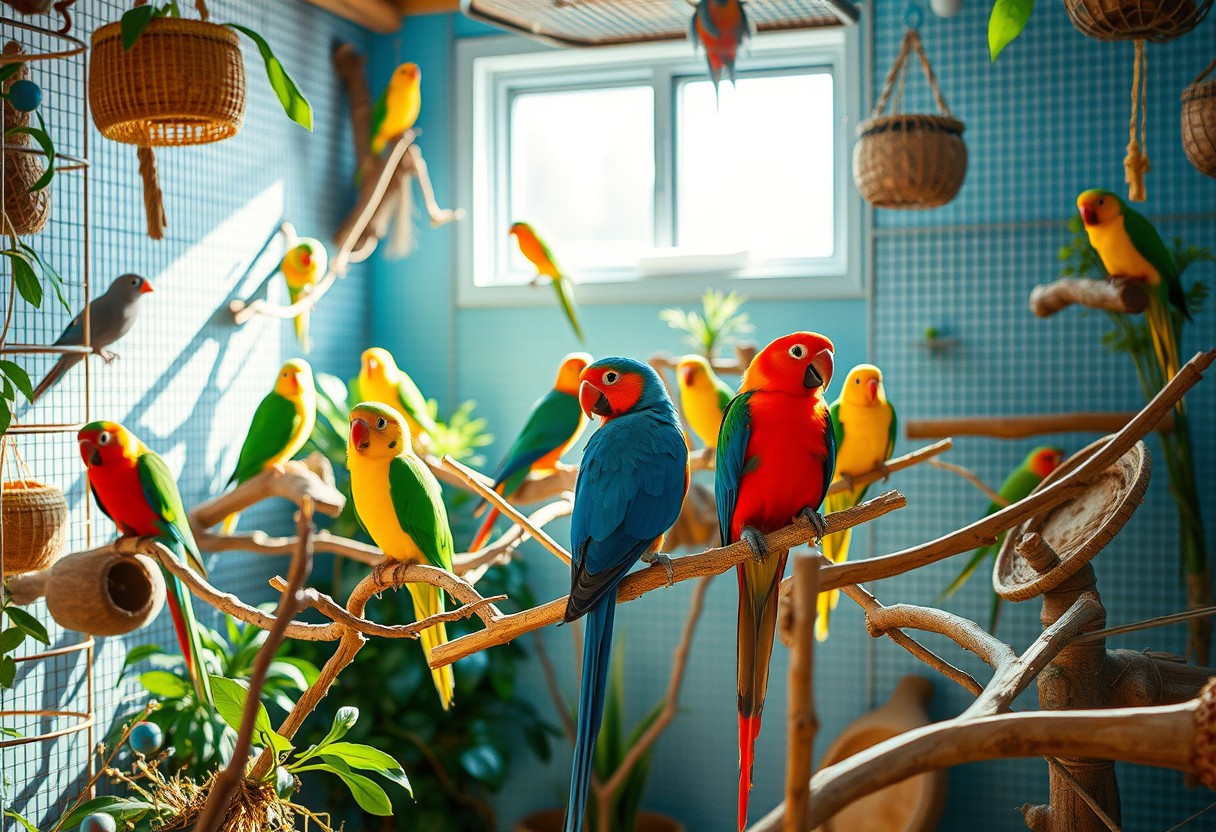
Routine Maintenance and Monitoring
To ensure that your pet bird thrives in its environment, routine maintenance and monitoring are important. This involves regular cleaning, health checks, and observing your bird’s behavior closely. These practices not only help to prevent illness but also contribute to the overall happiness and well-being of your feathered companion.
Regular Cleaning Procedures
Cleaning your bird’s cage and surrounding area is critical for maintaining a healthy environment. You should perform daily tasks such as removing uneaten food, wiping down surfaces, and refreshing the water regularly. Weekly deep cleaning should also be part of your routine; this involves removing all items from the cage, scrubbing surfaces with bird-safe cleaners, and replacing the bedding. A clean environment reduces the risk of diseases and minimizes unpleasant odors.
Remember to pay special attention to areas that often get overlooked, like food dishes and perches. These spots can harbor bacteria and should be cleaned thoroughly. Perform a monthly inspection of your bird’s cage for any signs of wear or damage to ensure its safety and integrity.
Health Checks and Observation
If you want to maintain your bird’s health, regular health checks and careful observation are key. Make it a habit to examine your bird for any signs of illness, including changes in feathers, droppings, or behavior. Daily observation helps you to identify any unusual patterns or changes that could indicate health issues. Ensure you are aware of your bird’s normal behavior—this will help you detect any abnormalities sooner.
Checks involving your bird’s weight, feather condition, and active engagement can indicate overall health. Conduct regular weigh-ins to ensure that your pet is maintaining a healthy weight, and note any significant weight changes. A bird that is losing weight rapidly could be experiencing health problems that require immediate veterinary attention. Keep a close eye on your bird’s activity levels—birds are naturally playful, and a sudden decrease in activity can be a warning sign.
Adjusting Environment Based on Behavior
To create a truly enriching space for your bird, be prepared to adjust its environment based on your observations. If your pet seems bored or agitated, consider introducing new toys, perches, or activities to stimulate their interest. Creating a dynamic environment promotes both physical and mental well-being. You should also ensure that the environment is safe, removing any potential hazards that could lead to injury.
It’s important to note that environmental changes should be gradual. Sudden alterations can be overwhelming for your bird, so introduce new items one at a time. Pay attention to how your bird interacts with these changes, noting reactions such as increased vocalization or exploration. This will help you better understand what adjustments contribute positively to their well-being.
Final Words
Now that you have a clear understanding of how to create a safe and stimulating environment for your pet bird, it’s necessary to remember that every bird is unique and may have different needs. By providing a well-designed cage, a variety of toys, and plenty of out-of-cage time, you can ensure that your feathered friend remains both physically and mentally healthy. It is also crucial to regularly assess your bird’s habitat for potential hazards, ensuring that it is free from toxic materials and unsafe items. Implementing these practices will foster a secure space where your bird can thrive.
Moreover, engaging with your pet on a regular basis is vital for its emotional well-being. Spend time training, playing, and bonding with your bird to enhance its socialization skills and reduce the risk of behavioral problems. By promoting a rich environment filled with interaction, stimulation, and safety, you not only enrich your bird’s life but also deepen the connection between you and your avian companion. In doing so, you are taking responsibility for their happiness and health, ensuring a rewarding experience for both of you.
FAQ
Q: What are the vital elements for creating a safe environment for my pet bird?
A: To ensure a safe environment for your pet bird, start by selecting an appropriate cage that is spacious enough for them to move around freely, with bar spacing that prevents escape. Avoid toxic materials; choose bird-safe toys and perches made from natural wood and non-toxic materials. Make sure that the area around the cage is free from hazards like open windows, ceiling fans, and other pets. Regularly inspect toys and accessories for wear and tear to prevent choking hazards and remove any harmful items like houseplants that may be toxic to birds.
Q: How can I stimulate my pet bird mentally and physically within their environment?
A: Stimulating your pet bird requires a variety of engaging activities. Incorporate a range of toys that promote physical activity, such as swings, climbing structures, and puzzle toys. Rotate toys regularly to keep their environment interesting. Bird-proof a designated space outside of the cage for supervised playtime where they can explore safe areas. Incorporating interactive play, such as teaching tricks or engaging in games, can also provide mental stimulation. Additionally, consider providing foraging opportunities by hiding treats within their toys or in various locations to encourage natural foraging behavior.
Q: How can I maintain a clean and healthy living space for my pet bird?
A: Maintaining cleanliness is crucial for your bird’s health. Begin by cleaning your bird’s cage regularly, ideally on a daily basis, by removing droppings, leftover food, and feathers. A thorough cleaning of the entire cage should occur weekly, including washing perches and toys with bird-safe detergents. Ensure that the area around the cage is also cleaned to prevent mold and the growth of bacteria. Additionally, provide fresh food and water daily, and monitor the bird’s bathing habits to keep their feathers clean. Regularly scheduled vet checkups can help ensure your bird’s overall well-being and a healthy environment.
